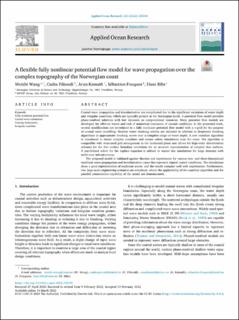| dc.contributor.author | Wang, Weizhi | |
| dc.contributor.author | Pakozdi, Csaba | |
| dc.contributor.author | Kamath, Arun | |
| dc.contributor.author | Fouques, Sebastien | |
| dc.contributor.author | Bihs, Hans | |
| dc.date.accessioned | 2022-08-05T12:42:45Z | |
| dc.date.available | 2022-08-05T12:42:45Z | |
| dc.date.created | 2022-02-21T18:39:28Z | |
| dc.date.issued | 2022 | |
| dc.identifier.citation | Applied Ocean Research. 2022, 122 . | en_US |
| dc.identifier.issn | 0141-1187 | |
| dc.identifier.uri | https://hdl.handle.net/11250/3010382 | |
| dc.description.abstract | Coastal wave propagation and transformation are complicated due to the significant variations of water depth and irregular coastlines, which are typically present at the Norwegian fjords. A potential flow model provides phase-resolved solutions with low demands on computational resources. Many potential flow models are developed for offshore waves and lack of numerical treatments of coastal conditions. In the presented work, several modifications are introduced to a fully nonlinear potential flow model with a -grid for the purpose of coastal wave modelling: Shallow water breaking criteria are included in addition to deepwater breaking algorithms to approximate breaking waves over a complete range of water depth. A new coastline algorithm is introduced to detect complex coastlines and ensure robust simulations near the coast. The algorithm is compatible with structured grid arrangement in the horizontal plane and allows for high-order discretisation schemes for the free surface boundary conditions for an accurate representation of complex free surfaces. A parallelised solver for the Laplace equation is utilised to ensure fast simulations for large domains with multi-core infrastructures. The proposed model is validated against theories and experiments for various two- and three-dimensional nonlinear wave propagation and transformation cases that represent typical coastal conditions. The simulations show a good representation of nonlinear waves, and the results compare well with experiments. Furthermore, two large-scale engineering scenarios are simulated, where the applicability of the coastline algorithm and the parallel commutation capability of the model are demonstrated. | en_US |
| dc.language.iso | eng | en_US |
| dc.publisher | Elsevier | en_US |
| dc.rights | Navngivelse 4.0 Internasjonal | * |
| dc.rights.uri | http://creativecommons.org/licenses/by/4.0/deed.no | * |
| dc.subject | Irregular coastline | en_US |
| dc.subject | Varying bathymetry | en_US |
| dc.subject | Coastal wave simulation | en_US |
| dc.subject | Fully nonlinear potential flow | en_US |
| dc.title | A Flexible Fully Nonlinear Potential Flow Model for Wave Propagation over the Complex Topography of the Norwegian Coast | en_US |
| dc.title.alternative | A Flexible Fully Nonlinear Potential Flow Model for Wave Propagation over the Complex Topography of the Norwegian Coast | en_US |
| dc.type | Peer reviewed | en_US |
| dc.type | Journal article | en_US |
| dc.description.version | publishedVersion | en_US |
| dc.rights.holder | © 2022 The Author(s). Published by Elsevier Ltd | en_US |
| dc.source.pagenumber | 28 | en_US |
| dc.source.volume | 122 | en_US |
| dc.source.journal | Applied Ocean Research | en_US |
| dc.identifier.doi | 10.1016/j.apor.2022.103103 | |
| dc.identifier.cristin | 2004263 | |
| dc.relation.project | Statens Vegvesen: 303624 | en_US |
| dc.relation.project | Norges forskningsråd: 267981 | en_US |
| dc.relation.project | Sigma2: NN2620K | en_US |
| dc.source.articlenumber | 103103 | en_US |
| cristin.ispublished | true | |
| cristin.fulltext | original | |
| cristin.qualitycode | 1 | |

